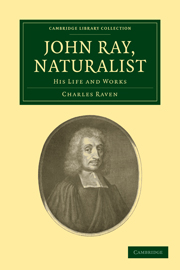Book contents
- Frontmatter
- Contents
- Preface
- Introduction
- ABBREVIATIONS
- Chapter I Boyhood and Youth
- Chapter II At Cambridge University
- Chapter III First Studies in Science
- Chapter IV The Cambridge Catalogue
- Chapter V The Years of Travel
- Chapter VI The English Catalogue
- Chapter VII The Years of Varied Output
- Chapter VIII The Structure and Classification of Plants
- Chapter IX The History of Plants
- Chapter X The Flora of Britain
- Chapter XI Last Work in Botany
- Chapter XII The Ornithology
- Chapter XIII The History of Fishes
- Chapter XIV Of Mammals and Reptiles
- Chapter XV The History of Insects
- Chapter XVI Of Fossils and Geology
- Chapter XVII The Wisdom of God
- Conclusion
- Index
Chapter II - At Cambridge University
Published online by Cambridge University Press: 07 September 2010
- Frontmatter
- Contents
- Preface
- Introduction
- ABBREVIATIONS
- Chapter I Boyhood and Youth
- Chapter II At Cambridge University
- Chapter III First Studies in Science
- Chapter IV The Cambridge Catalogue
- Chapter V The Years of Travel
- Chapter VI The English Catalogue
- Chapter VII The Years of Varied Output
- Chapter VIII The Structure and Classification of Plants
- Chapter IX The History of Plants
- Chapter X The Flora of Britain
- Chapter XI Last Work in Botany
- Chapter XII The Ornithology
- Chapter XIII The History of Fishes
- Chapter XIV Of Mammals and Reptiles
- Chapter XV The History of Insects
- Chapter XVI Of Fossils and Geology
- Chapter XVII The Wisdom of God
- Conclusion
- Index
Summary
Ad Joannem Raium
Quondam discipulus Rai mihi docte fuisti:
Nunc cedo ac herbam porrigo, amice, tibi.
Multa Dioscorides, Theophrastus, Plinius ingens,
(Dicet posteritas) omnia Raius habet.
James Duport, Musae Subsecivae, p. 395.When Ray came into residence Cambridge, or at least the centre of the town, was externally not unlike its modern self. The river had been brought into its present course; the island opposite Trinity had been removed; the sites of the chief bridges had been fixed; the main streets had taken their present form. The Colleges, save for the four foundations of the nineteenth century, were all established. The great period of building which created the library of St John's, the first court of Clare and the fellows' building of Christ's, had just closed. Apart from the third court of St John's and the work of Wren, the chapels of Pembroke and Emmanuel and the library of Trinity, the town was the same as it is in Loggan's map, published in 1688, and almost as it remained for more than a century. There was no Senate-house: Ray's friend, Isaac Barrow, failed to persuade the University to emulate Fell's Sheldonian at Oxford; and until 1722 dwellings, the Devil's Tavern and the Regent's Walk occupied its present site and most of the west side of Trumpington Street. Exercises were kept and degrees conferred in the University Church, where even in Puritan days the broad witticisms of Praevaricator or Tripos were not often taken amiss.
- Type
- Chapter
- Information
- John Ray, NaturalistHis Life and Works, pp. 21 - 42Publisher: Cambridge University PressPrint publication year: 2009First published in: 1942



